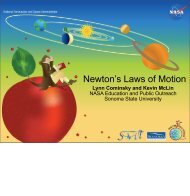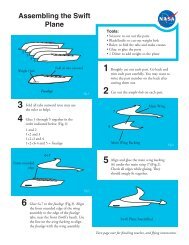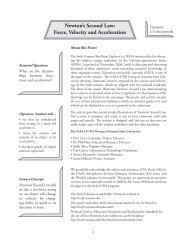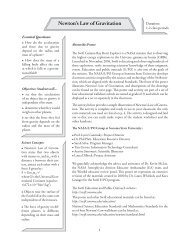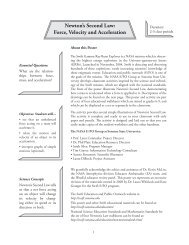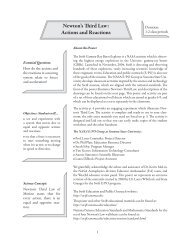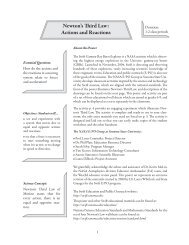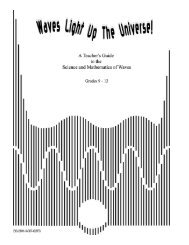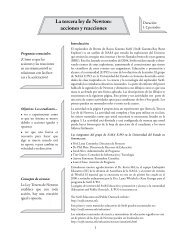Newton's First Law: Inertia and Unbalanced Forces - Swift - Sonoma ...
Newton's First Law: Inertia and Unbalanced Forces - Swift - Sonoma ...
Newton's First Law: Inertia and Unbalanced Forces - Swift - Sonoma ...
- No tags were found...
You also want an ePaper? Increase the reach of your titles
YUMPU automatically turns print PDFs into web optimized ePapers that Google loves.
as it was for it to be at rest. It was only in our imperfect, friction-filled world that we needed to continue topush an object to get it to move.Isaac Newton built upon Galileo’s ideas. He agreed that an object would continue to move even if no forceacted on it. He also understood that more than one force can act on an object at the same time. The combinationof these forces is important. For example, imagine two teams playing tug-of-war; each pulls on a ropein opposite directions. If one team is stronger, then their force is greater <strong>and</strong> they pull the other team towardthem. In this situation, when two forces are not equal, we say they are unbalanced. However, if the two teamshave equal strength, the force they apply to the rope is equal – balanced– <strong>and</strong> neither team moves.In his work known as the “Principia,” published in 1687, Newton wrote about his ideas on forces <strong>and</strong> motion(<strong>and</strong> readily acknowledged his debt to Galileo). He created three laws, today called Newton’s <strong>Law</strong>s of Motion.His <strong>First</strong> <strong>Law</strong> of Motion stated: A body continues at rest or in motion in a straight line with a constant speeduntil acted on by an unbalanced force. The tendency of a body to resist change is called inertia. Newton’s <strong>First</strong><strong>Law</strong> is often referred to as the <strong>Law</strong> of <strong>Inertia</strong>.Newton’s <strong>Law</strong>s apply to macroscopic systems – things you can feel <strong>and</strong> see. There are environments for whichNewton’s <strong>Law</strong>s (or Classical Mechanics) only provide an approximate answer, <strong>and</strong> more general physical lawsmust be used. For example, black holes <strong>and</strong> objects moving at nearly the speed of light are more accuratelyexplained by General Relativity, while subatomic particles are explained by Quantum Mechanics.Pre-Activity Reading:Newton’s <strong>First</strong> <strong>Law</strong> <strong>and</strong> the <strong>Swift</strong> SatelliteOn November 20, 2004, the <strong>Swift</strong> satellite was sealed in the nosecone of a Delta 2 rocket, ready for launchfrom Cape Canaveral, Florida. Immediately prior to launch, <strong>Swift</strong> was “an object at rest” <strong>and</strong> so was the rocket.There was no unbalanced force on <strong>Swift</strong> or the rocket, so both of them remained at rest. When the solid rocketboosters ignited at 12:16:00 p.m. EST, an unbalanced force was applied to the rocket. For the first few secondsof the launch, the rocket exhaust went straight down, pushing the rocket straight up, in a line. You can see the<strong>Swift</strong> launch in a video at:http://www.nasa.gov/mission_pages/swift/multimedia/index.htmlPre-Activity Discussion:Ask the following questions to introduce Newton’s <strong>First</strong> <strong>Law</strong> to your class:• When were the <strong>Swift</strong> satellite <strong>and</strong> rocket at rest?• When were the <strong>Swift</strong> satellite <strong>and</strong> rocket in motion in a straight line?• What happens when you are riding in a car with a seat belt on, <strong>and</strong> the car starts or stops suddenly?• What would happen if you were not wearing your seat belt?• What is providing the unbalanced force for the <strong>Swift</strong> launch? For the car?• Can you think of some more examples when your body is in motion <strong>and</strong> it is acted on by an unbalancedforce?3



